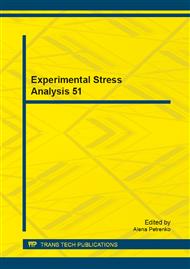p.26
p.32
p.36
p.42
p.48
p.54
p.58
p.62
p.66
Memorization and other Transient Effects of ST52 Steel and its FE Description
Abstract:
This contribution presents main results of experimental tests realized on smooth specimens made of ST52 steel under strain controlled uniaxial cyclic loading and compares these results with numerical simulations performed using a modified Chaboche model by finite element method. The effects of NonMasings behavior, memorization, cyclic hardening/softening and mean stress relaxation have been studied at room temperature. The experiments were realized on the reconstructed hydraulic fatigue testing machine INOVA 100 at the Laboratory of modern materials testing and defectoscopy of VŠB-TU Ostrava. Developed mixed hardening material model includes a memory surface stated in stress-space, which makes possible to significantly improve prediction of effects studied.
Info:
Periodical:
Pages:
48-53
Citation:
Online since:
December 2013
Authors:
Price:
Сopyright:
© 2014 Trans Tech Publications Ltd. All Rights Reserved
Share:
Citation:


